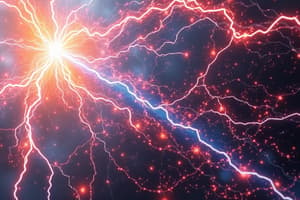Podcast
Questions and Answers
Two point charges, +q and -q, are placed a distance d apart. What happens to the magnitude of the electrostatic force between them if the distance is doubled?
Two point charges, +q and -q, are placed a distance d apart. What happens to the magnitude of the electrostatic force between them if the distance is doubled?
- It quadruples.
- It doubles.
- It is reduced to one-quarter of its original value. (correct)
- It is reduced to one-half of its original value.
Three identical charges are placed at the vertices of an equilateral triangle. In what direction is the net electrostatic force on each charge?
Three identical charges are placed at the vertices of an equilateral triangle. In what direction is the net electrostatic force on each charge?
- Towards the center of the triangle
- The net force is zero
- Parallel to the side opposite the vertex
- Away from the center of the triangle (correct)
Which statement accurately describes the relationship between electric field strength and electric field lines surrounding a charged object?
Which statement accurately describes the relationship between electric field strength and electric field lines surrounding a charged object?
- Electric field strength is weaker where electric field lines are closer together.
- Electric field strength is stronger where electric field lines are farther apart.
- Electric field strength is stronger where electric field lines are closer together. (correct)
- Electric field strength is constant, regardless of the spacing of electric field lines.
Why can electric field lines never cross each other?
Why can electric field lines never cross each other?
A closed surface contains an electric dipole. According to Gauss's Law, what is the net electric flux through the surface?
A closed surface contains an electric dipole. According to Gauss's Law, what is the net electric flux through the surface?
A charge +Q is placed inside a spherical Gaussian surface. If the radius of the Gaussian surface is doubled, what happens to the electric flux through the surface?
A charge +Q is placed inside a spherical Gaussian surface. If the radius of the Gaussian surface is doubled, what happens to the electric flux through the surface?
A point charge is surrounded by two Gaussian surfaces, a small sphere and a larger cube. How does the electric flux through each surface compare?
A point charge is surrounded by two Gaussian surfaces, a small sphere and a larger cube. How does the electric flux through each surface compare?
What is the electric field inside a conductor in electrostatic equilibrium?
What is the electric field inside a conductor in electrostatic equilibrium?
An electric dipole is placed in a uniform electric field. Under what condition is the potential energy of the dipole minimum?
An electric dipole is placed in a uniform electric field. Under what condition is the potential energy of the dipole minimum?
A dielectric material is inserted between the plates of a capacitor. How does this affect the electric field between the plates?
A dielectric material is inserted between the plates of a capacitor. How does this affect the electric field between the plates?
What is the net charge enclosed within a Gaussian surface if the electric flux through it is zero?
What is the net charge enclosed within a Gaussian surface if the electric flux through it is zero?
How does the electric field vary with distance from an infinitely long charged wire?
How does the electric field vary with distance from an infinitely long charged wire?
A charged particle is placed in an electric field. Under what condition will the particle experience the greatest force?
A charged particle is placed in an electric field. Under what condition will the particle experience the greatest force?
Which of the following is true about conductors in electrostatic equilibrium?
Which of the following is true about conductors in electrostatic equilibrium?
Two charges, +4q and -q, are placed a certain distance apart. At what point on the line joining the two charges is the electric field zero?
Two charges, +4q and -q, are placed a certain distance apart. At what point on the line joining the two charges is the electric field zero?
How does the electrostatic force between two charged objects change if the magnitude of each charge is doubled and the distance between them is halved?
How does the electrostatic force between two charged objects change if the magnitude of each charge is doubled and the distance between them is halved?
The electric field lines around an isolated positive charge:
The electric field lines around an isolated positive charge:
A spherical conductor has a net charge on it. Where does the excess charge reside?
A spherical conductor has a net charge on it. Where does the excess charge reside?
What is the torque on an electric dipole when it is aligned parallel to the electric field?
What is the torque on an electric dipole when it is aligned parallel to the electric field?
Which of the following materials allows electric charges to move freely?
Which of the following materials allows electric charges to move freely?
Flashcards
Electric Charge
Electric Charge
A fundamental property of matter causing it to experience a force in the presence of other charged matter.
Coulomb's Law
Coulomb's Law
The electrostatic force between two point charges is directly proportional to the product of the magnitudes of the charges and inversely proportional to the square of the distance between them.
Coulomb's Law Formula
Coulomb's Law Formula
k * |q1 * q2| / r², where k is Coulomb's constant, q1 and q2 are the magnitudes of the charges, and r is the distance between the charges.
Electric Field Lines
Electric Field Lines
Signup and view all the flashcards
Origin and Termination of Electric Field Lines
Origin and Termination of Electric Field Lines
Signup and view all the flashcards
Density of Field Lines
Density of Field Lines
Signup and view all the flashcards
Electric Field (E)
Electric Field (E)
Signup and view all the flashcards
Gauss's Law
Gauss's Law
Signup and view all the flashcards
Electric Flux (ΦE)
Electric Flux (ΦE)
Signup and view all the flashcards
Electric Flux Formula
Electric Flux Formula
Signup and view all the flashcards
Gauss's Law Formula
Gauss's Law Formula
Signup and view all the flashcards
Electric Field Inside a Conductor
Electric Field Inside a Conductor
Signup and view all the flashcards
Electric Dipole
Electric Dipole
Signup and view all the flashcards
Dipole Moment (p)
Dipole Moment (p)
Signup and view all the flashcards
Torque on a Dipole
Torque on a Dipole
Signup and view all the flashcards
Potential Energy of a Dipole
Potential Energy of a Dipole
Signup and view all the flashcards
Conductors
Conductors
Signup and view all the flashcards
Insulators
Insulators
Signup and view all the flashcards
Polarization
Polarization
Signup and view all the flashcards
Study Notes
- Electric charge is a fundamental property of matter that causes it to experience a force when near other electrically charged matter
- Electric charge exists in discrete units, as integer multiples of the elementary charge (e ≈ 1.602 × 10⁻¹⁹ Coulombs)
- Charges are of two types: positive and negative; like charges repel and unlike charges attract
Coulomb's Law
- Coulomb's Law quantifies the electrostatic force (F) between two point charges
- The electrostatic force (F) is directly proportional to the product of the magnitudes of the charges (|q1| and |q2|)
- The electrostatic force (F) is inversely proportional to the square of the distance (r) between them
- The electrostatic force (F) acts along the line joining the two charges
- Mathematically, Coulomb's Law is expressed as: F = k * |q1 * q2| / r², where k is Coulomb's constant, k ≈ 8.9875 × 10⁹ N⋅m²/C²
- The force is repulsive if the charges have the same sign and attractive if the charges have opposite signs
- In vector form, the electrostatic force on charge q1 due to charge q2 is F12 = k * q1 * q2 / r² * r̂12, where r̂12 is the unit vector pointing from q2 to q1
- The superposition principle applies to electrostatic forces: the total force on a charge due to multiple other charges is the vector sum of the individual forces
Electric Field Lines
- Electric field lines are a visual representation of the electric field in space
- They originate from positive charges and terminate on negative charges
- The density of field lines indicates the strength of the electric field: more lines per unit area indicate a stronger field
- Electric field lines never cross each other
- The direction of the electric field at any point is tangent to the field line at that point
- For a positive point charge, the electric field lines radiate outwards
- For a negative point charge, the electric field lines converge inwards
- The electric field lines are perpendicular to the surface of a charged conductor in electrostatic equilibrium
- The electric field is stronger where the field lines are closer together
Electric Field
- The electric field (E) is defined as the force per unit positive charge experienced by a test charge placed in the field
- Mathematically, E = F/q, where F is the electrostatic force on the test charge q
- The electric field points in the direction of the force on a positive test charge
- The electric field due to a point charge q at a distance r is E = k * q / r² * r̂, where r̂ is the unit vector pointing from the charge to the point where the field is being calculated
- The superposition principle applies to electric fields: the total electric field at a point due to multiple charges is the vector sum of the individual electric fields
Gauss's Law
- Gauss's Law relates the electric flux through a closed surface to the enclosed electric charge
- Electric flux (ΦE) is a measure of the number of electric field lines passing through a surface
- For a uniform electric field E passing through a flat surface of area A, the electric flux is ΦE = E ⋅ A = E A cos θ, where θ is the angle between the electric field and the normal to the surface
- Gauss's Law states that the total electric flux through a closed surface (Gaussian surface) is proportional to the enclosed electric charge: ΦE = ∮ E ⋅ dA = Qenc / ε₀, where Qenc is the net charge enclosed by the surface and ε₀ is the permittivity of free space (ε₀ ≈ 8.854 × 10⁻¹² C²/N⋅m²)
- Gauss's Law can be used to calculate the electric field for charge distributions with sufficient symmetry
- Common Gaussian surfaces include spheres, cylinders, and boxes
Applications of Gauss's Law
- Spherical Symmetry: For a spherically symmetric charge distribution, a spherical Gaussian surface is used to find the electric field at a distance r from the center
- Cylindrical Symmetry: For an infinitely long charged cylinder, a cylindrical Gaussian surface is used to find the electric field at a radial distance r from the axis
- Planar Symmetry: For an infinite charged plane, a cylindrical Gaussian surface is used to find the electric field near the plane
- Conductors: Inside a conductor in electrostatic equilibrium, the electric field is zero. All excess charge resides on the surface of the conductor
- The electric field at the surface of a charged conductor is perpendicular to the surface and has a magnitude of E = σ / ε₀, where σ is the surface charge density
Electric Dipole
- An electric dipole consists of two equal and opposite charges (+q and -q) separated by a distance d
- The dipole moment (p) is a vector pointing from the negative charge to the positive charge, with magnitude p = qd
- The electric field due to a dipole at a point far from the dipole (r >> d) depends on the dipole moment and the distance
- Torque on a dipole in an electric field: τ = p × E, where τ is the torque, p is the dipole moment, and E is the electric field
- Potential energy of a dipole in an electric field: U = -p ⋅ E = -pE cos θ, where U is the potential energy and θ is the angle between p and E
Conductors and Insulators
- Conductors are materials that allow electric charges to move freely through them (e.g., metals)
- In conductors, electrons are not bound to specific atoms and can move easily in response to an electric field
- Insulators (dielectrics) are materials that do not allow electric charges to move freely (e.g., glass, rubber)
- In insulators, electrons are tightly bound to atoms and cannot move easily
- When a conductor is placed in an electric field, charges redistribute themselves on the surface such that the electric field inside the conductor is zero in electrostatic equilibrium
- When an insulator is placed in an electric field, the molecules become polarized, creating an induced electric field that opposes the external field
Studying That Suits You
Use AI to generate personalized quizzes and flashcards to suit your learning preferences.




